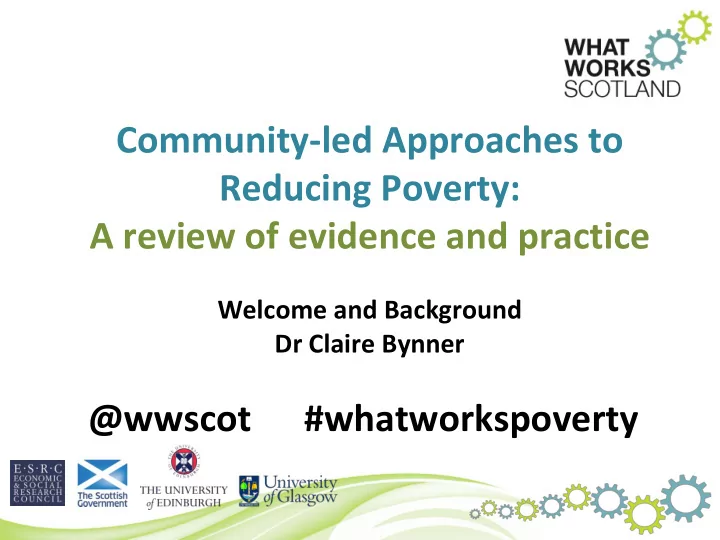

Community-led Approaches to Reducing Poverty: A review of evidence and practice Welcome and Background Dr Claire Bynner @wwscot #whatworkspoverty
• A three-year project led by researchers at University of Glasgow and University of Edinburgh • Funded by the ESRC and the Scottish Government • To support and improve public services in Scotland
W orking at a national level with: • Glasgow Centre for Population Health • Healthcare Improvement Scotland • Improvement Service • Inspiring Scotland • Institute for Research and Innovation in Social Sciences • NHS Education for Scotland • NHS Health Scotland • Scottish Council for Voluntary Organisations • Scottish Community Development Centre
Working in partnership with:
• Action research projects Collaborative • Capture learning across projects Action • Disseminate across partners, Research CPPs, etc. • Understanding the evidence Evidence into landscape • Enhancing capacity to use action evidence
Guidelines for Good Dialogue • Give everyone space to speak – one voice at a time • Listen actively to what everyone has to say • Make your points concisely – share the air time • Respect different views - try to understand one another better
Carousel of Community-led approaches • The evidence review identified 5 types of community-led approach. Around the room there are 5 stations – one for each ‘type’ • At each station we would like you to discuss the contribution of the approach to tackling poverty and the support needed • The groups will rotate around the stations in a clockwise direction until all have been visited. Chair will ring the bell to move the groups on. • Each group has a different colour marker for recording their answers to the questions, which is done by a facilitator at each station. The facilitator may clarify the contributions of previous groups if needed. • The idea is that each successive group reads, reflects on and adds to the answers of the previous groups, producing a comprehensive view in a short period of time.
Carousel Questions • What contribution can this type of community-led activity make to reducing poverty? • How can these activities be supported and strengthened?
Carousel review • The flipchart sheets represent your cumulative wisdom. Take 5 minutes to go look at the topics around the room and then make your way back to your table. • The charts will stay up for the duration of the event
Policy implications (1) • Please return to your table • Take 5 mins reflective time to write your thoughts on • Use post-it notes . Up to 3 max for each question: What are the implications of what you have learnt today for local policy? What are the implications of what you have learnt today for national policy ?
Policy implications (2) • Local policy (10mins) – Lay out your post – its – Read the answers – Look for common themes and try to cluster the post it notes – If possible add headings to summarise the groups • National policy - repeat the process (10mins)
Policy implications (3) • Chair gives 5 minute warning (bell!) • Identify the most important local and national policy implications to feed back to the wider group 1 top point for local 1 top point for national
Key Listeners – Amanda Coultard , Community Planning West Dunbartonshire – Prof Ken Gibb, What Works Scotland Co- Director
Wrapping Up Don’t forget to complete evaluation forms Thank-you! @wwscot #whatworkspoverty
Recommend
More recommend